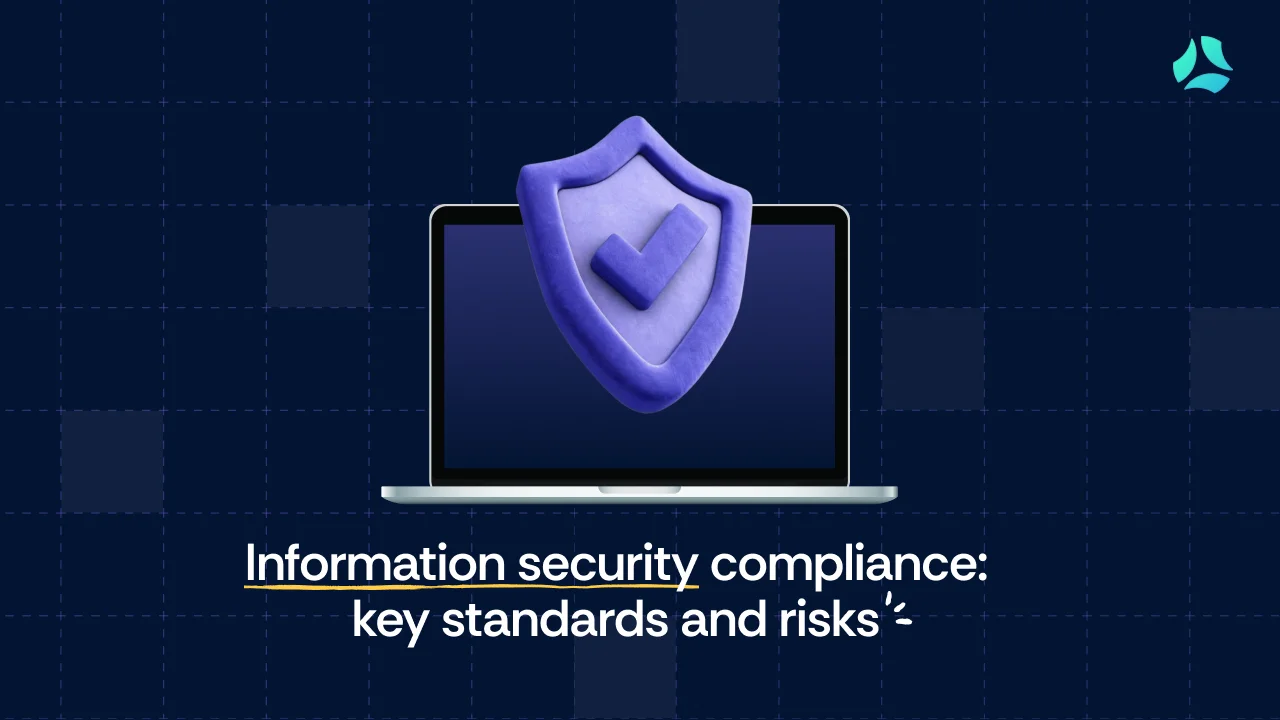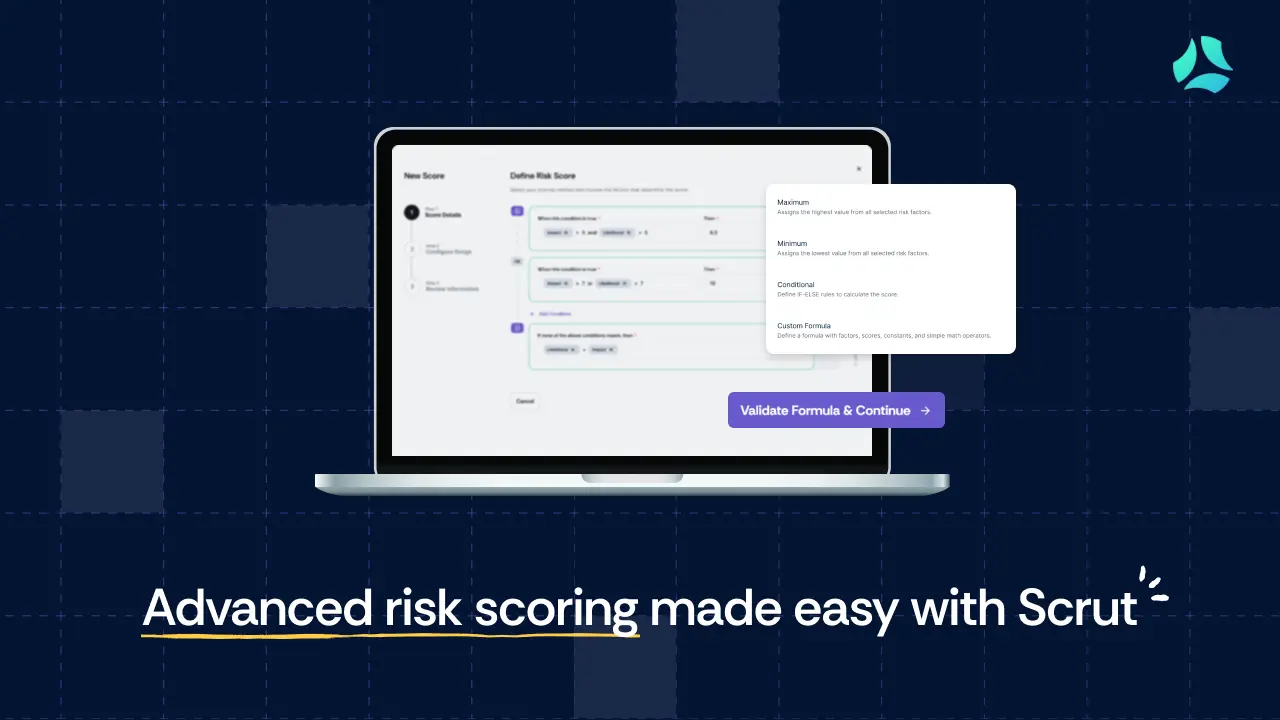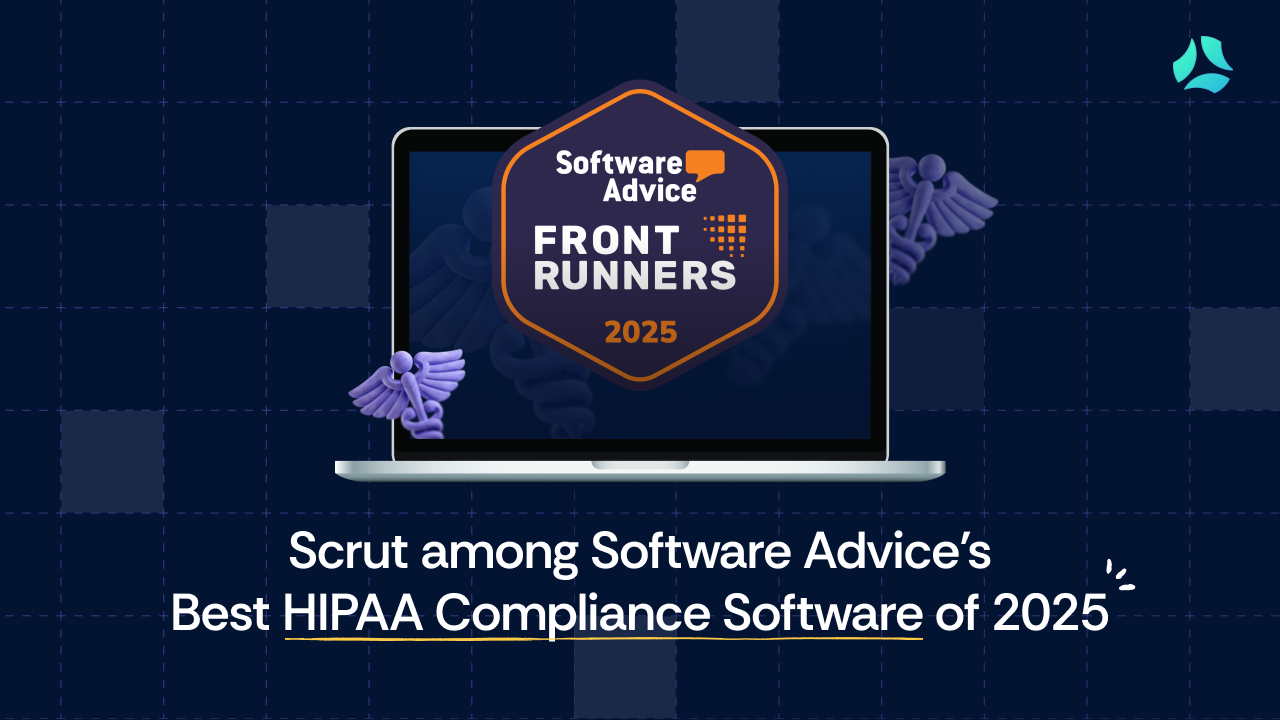Information Security Compliance: Meaning, Regulations, Benefits

Information security compliance today goes far beyond ticking regulatory checklists. It’s about adapting to stricter enforcement, evolving data protection requirements across borders, and rising expectations from customers and regulators. Organizations are now evaluated on how proactively they demonstrate accountability, transparency, and resilience to emerging risks.
Protecting sensitive information has become a business-critical priority. As data breaches, cyberattacks, and new regulations continue to surface, compliance with recognized security frameworks is essential for safeguarding networks, systems, and data.
Beyond avoiding fines or penalties, a strong compliance posture signals reliability and builds trust with customers, partners, and regulators. This guide explores what information security compliance means, why it matters, the key standards to follow, how to implement it effectively, and the risks of falling short, so you can approach compliance strategically and protect your organization’s most valuable assets.
What is information security compliance?
Information security compliance is the ongoing effort to align your organization's security practices with applicable laws, regulations, and industry standards to protect the confidentiality, integrity, and availability of data. This involves implementing policies, procedures, and controls that ensure the confidentiality, integrity, and availability of information. In 2025, compliance is not just about avoiding penalties; it's about building a resilient, trustworthy organization that can navigate the complex landscape of cybersecurity threats and regulatory requirements.
As cyber threats become more sophisticated and regulatory frameworks evolve, organizations must stay vigilant and proactive in their compliance efforts. Failure to do so can result in severe consequences, including data breaches, financial penalties, and reputational damage.
Why IT compliance matters
1. Protects sensitive data
Information security compliance helps organizations protect critical data, including personal, financial, health, or intellectual property, by aligning practices with recognized standards and regulations. In 2025, with hybrid work environments and cloud adoption on the rise, companies face growing exposure to ransomware, phishing attacks, and insider threats. Frameworks and regulations such as ISO 27001, HIPAA, SOC 2, PCI-DSS, and GDPR establish requirements or guidelines that strengthen data protection. While technical standards like ISO 27001, SOC 2, and PCI-DSS prescribe structured security controls (e.g., access management, encryption, audit logging), regulations such as HIPAA and GDPR focus more on defining obligations and principles organizations must meet to safeguard sensitive information.
2. Mitigates legal and financial risks
Non-compliance can carry significant financial consequences. For example:
- Under GDPR, fines can reach up to 4% of annual global turnover.
- HIPAA penalties vary by violation category and culpability; for severe cases of willful neglect that are not corrected, civil fines can now reach up to $2,134,831 for violations of the same provision in a calendar year.
- PCI-DSS non-compliance does not carry fines defined within the standard itself. Instead, penalties are imposed by payment brands and acquiring banks, which may include substantial monetary fines and even suspension of payment processing privileges.
Beyond regulatory fines, failure to comply can lead to costly litigation, contract termination, and lost business opportunities. By implementing robust compliance programs, organizations demonstrate due diligence and reduce their exposure to these risks.
3. Builds trust and reputation
Compliance signals reliability and professionalism to customers, partners, and regulators. Organizations that maintain adherence to standards such as ISO 27001, SOC 2, and PCI-DSS demonstrate a clear commitment to protecting data and maintaining operational integrity. In 2025, trust has become a key differentiator, with customers, investors, and partners increasingly seeking evidence that organizations follow robust compliance practices before engaging in business relationships.
IT compliance vs IT security: A quick distinction
While closely related, IT compliance and IT security are distinct:
- IT security focuses on protecting systems, networks, and data from threats such as malware, ransomware, and unauthorized access. It also encompasses processes like continuous monitoring, incident response, and recovery to prevent breaches and ensure operational integrity.
- IT compliance ensures that security measures meet specific legal, regulatory, or contractual requirements. It involves demonstrating that appropriate defenses are in place and functioning effectively, while also proving and maintaining evidence through audits, assessments, and documentation.
In practical terms, security is the defense; compliance is the evidence. For instance, a company may implement multi-factor authentication to secure accounts (security), but documenting, monitoring, and reporting that these controls are operational aligns with compliance requirements such as ISO 27001 or SOC 2.
Types of data covered by information security

Information security compliance extends far beyond securing passwords or firewalls; it encompasses the protection of all data that an organization collects, processes, or stores. In 2025, with the rapid adoption of cloud services, hybrid work environments, and global digital transactions, organizations face an increasingly complex landscape of sensitive information. Regulatory bodies and industry standards now require companies to understand not just where data resides, but also how it flows across systems, who can access it, and how it is protected from cyber threats, misuse, or accidental exposure.
Effective compliance starts with a clear understanding of the data landscape. Identifying the nature and sensitivity of your data is critical to applying the right controls, ensuring legal compliance, and mitigating security risks.
Different compliance frameworks focus on protecting specific types of data. Key categories include:
- Personal data: Names, addresses, contact details, and identifiers such as IP addresses, biometric data, or government-issued IDs.
- Financial data: Payment information, banking details, and transaction records
- Sensitive or regulated data: This includes categories such as health records, which are protected under privacy regulations; intellectual property, which encompasses proprietary company information; and trade secrets, which are critical business secrets requiring confidentiality.
Organizations must identify the types of data they handle to determine which standards and controls apply.
Key information security compliance standards
Organizations often need to comply with multiple frameworks depending on industry, geography, and risk profile. Key standards include:
1. HIPAA (Health Insurance Portability and Accountability Act)
HIPAA applies to healthcare organizations in the U.S. as well as to business associates that handle protected health information (PHI). It mandates administrative, physical, and technical safeguards to ensure the confidentiality, integrity, and security of patient data.
2. ISO 27001
ISO 27001 is an international standard for establishing, implementing, maintaining, and continually improving an Information Security Management System (ISMS). It provides a framework for managing information security risks organization-wide, ensuring the confidentiality, integrity, and availability of information, not just data.
3. SOC 2
Developed by the American Institute of CPAs, SOC 2 focuses on operational controls for service providers. It evaluates criteria such as security, availability, processing integrity, confidentiality, and privacy, though not all criteria are mandatory for every audit and may vary based on organizational needs.
4. PCI-DSS (Payment Card Industry Data Security Standard)
PCI-DSS applies to organizations that handle cardholder data. It establishes strict security controls to protect payment information and reduce the likelihood of data breaches, as part of contractual obligations with payment networks.
5. GDPR (General Data Protection Regulation)
GDPR regulates the personal data of individuals in the EU/EEA, setting strict rules on data collection, storage, processing, and cross-border transfers, with significant fines for non-compliance.
Each standard addresses unique risks but shares the common goal of protecting sensitive information and maintaining accountability.
How to implement information security compliance
Implementing compliance is a continuous process, not a one-time activity. Organizations should follow a structured approach:
1. Define scope and responsibilities
Identify which systems, data, and business units fall under compliance requirements. Assign owners and establish accountability for policies, audits, and reporting.
2. Conduct risk assessment
Evaluate the likelihood and impact of potential security incidents, and map vulnerabilities, threats, and regulatory gaps to prioritize controls. Develop and implement risk treatment plans to address identified risks and reduce their potential impact.
3. Develop and enforce policies
Establish a governance layer by documenting security policies, procedures, and controls. Ensure employees understand their responsibilities through training, access controls, and clear communication, and maintain oversight to enforce compliance and accountability.
4. Implement technical controls
Deploy a mix of administrative, technical, and physical controls to enforce compliance. This can include security measures such as encryption, firewalls, multi-factor authentication, access management, and monitoring systems, combined with policies and procedures to manage risk effectively.
5. Monitor and audit continuously
Regularly check systems, processes, and documentation to ensure ongoing compliance. Conduct internal audits, carry out management reviews, and implement corrective actions as needed. Prepare for external assessments to identify and address gaps early.
6. Respond and improve
Manage incidents, remediate gaps, and update policies as regulations evolve. Conduct management reviews and implement corrective actions as part of a continuous improvement cycle to ensure compliance remains effective and adaptive.
Consequences of non-compliance

Failing to comply with information security standards is not just a procedural misstep, it can have far-reaching consequences for any organization. Beyond regulatory fines, non-compliance can disrupt operations, damage reputation, and erode the trust of customers, partners, and investors. In a landscape where data breaches and cyberattacks are increasingly common, the cost of neglecting compliance can far exceed the investment required to maintain it. Key risks include:
- Legal penalties: Fines imposed by regulatory bodies and potential lawsuits from private parties, such as customers or business partners.
- Data breaches: Loss of sensitive data leading to operational and reputational harm.
- Business disruption: Service outages, contract terminations, and lost opportunities.
- Customer trust erosion: Clients may switch to competitors due to perceived risk.
How Scrut helps simplify InfoSec compliance
Navigating information security compliance can be complex, time-consuming, and prone to errors, especially when organizations must align with multiple frameworks simultaneously. Scrut simplifies this process by automating repetitive tasks, centralizing critical documentation, and providing real-time visibility into your compliance posture. With Scrut, organizations can stay audit-ready, reduce operational overhead, and focus on strategic initiatives that strengthen their overall IT security program. Key ways Scrut helps include:
- Centralized policy and document management: Store and manage all compliance-related files in one place with version control, approvals, and ready-to-use templates. This ensures consistency, traceability, and quick access during audits or reviews.
- Cross-framework efficiency: Map controls across different standards (e.g., ISO 27001, SOC 2, PCI-DSS) and regulations (e.g., HIPAA, GDPR). This reduces duplication and ensures a unified compliance strategy across complex environments.
- Automated evidence collection: Reduce manual tasks by automatically testing, monitoring, and logging controls. Continuous evidence collection keeps compliance data up-to-date and simplifies audit preparation.
- Continuous audit readiness: Dashboards and real-time reporting provide a clear view of your compliance posture, track risks, and ensure the organization remains audit-ready year-round, minimizing last-minute scramble before audits.
- Focus on strategic security initiatives: By automating repetitive compliance tasks, Scrut frees up IT and security teams to work on higher-value activities, such as strengthening security architecture, responding to emerging threats, and implementing proactive risk mitigation.

FAQ
1. What are the types of information security?
Information security covers multiple areas, including network security to protect networks from unauthorized access and attacks, application security to prevent software vulnerabilities like SQL injection, cloud security to secure data stored in cloud environments, endpoint security to safeguard devices such as laptops and servers, and data security to ensure the confidentiality, integrity, and availability of information.
2. What is required for IT compliance security?
Effective IT compliance requires clear policies and procedures for data handling and incident response, regular risk assessments to identify and mitigate threats, technical controls such as encryption, access management, and monitoring, audits and ongoing monitoring to verify control implementation, and employee training to ensure awareness and adherence.
3. How often should IT compliance audits be performed?
IT compliance audits should generally be conducted at least annually, though continuous monitoring or spot checks throughout the year can help proactively identify and remediate risks. High-risk industries may require quarterly or event-triggered audits.
4. Who should own compliance and security?
Compliance ownership typically resides with a dedicated compliance officer or Chief Information Security Officer (CISO), supported by IT and security teams, while senior management provides accountability for resources, policies, and risk decisions.
5. What happens if we fail a compliance audit?
Failing a compliance audit requires documenting deficiencies, implementing remediation plans, and verifying their effectiveness. Repeated non-compliance can result in regulatory fines, contractual penalties, loss of certifications, and reputational damage.
6. Is compliance software worth it for small businesses?
Yes, compliance automation reduces manual effort, ensures consistent adherence across multiple frameworks, provides audit-ready evidence, and supports growth by building trust with clients and partners.
7. How do global data privacy laws impact IT compliance?
Organizations operating internationally must comply with regulations such as GDPR, CCPA/CPRA, HIPAA, and PDPA, covering proper data collection, processing, storage, cross-border transfers, and breach notifications, with non-compliance leading to fines, litigation, and operational restrictions.
8. Can cybersecurity and IT compliance be managed together?
Yes, integrating cybersecurity with compliance reduces duplication and improves efficiency, as security measures like access controls, encryption, monitoring, and incident response satisfy both operational security needs and regulatory requirements.
9. What technical measures ensure compliance?
Key technical measures include encryption for data at rest and in transit, role-based access management with multi-factor authentication, monitoring and logging to detect anomalies, incident response procedures for timely containment and reporting, and continuous audits with automated evidence collection.
10. Which industries are most affected by information security compliance?
Industries handling sensitive data or operating under strict regulations are most impacted, including healthcare, finance, technology and cloud service providers, government and defense, and any organization managing personal or financial data.
11. How can organizations remain compliant with changing rules?
Organizations can maintain compliance through regular audits and gap analyses, timely policy updates aligned with new regulations, ongoing employee training, and automation tools like Scrut to continuously monitor controls, collect evidence, and streamline compliance across multiple frameworks.


















